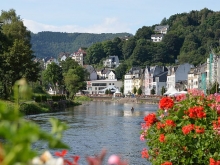Latvia
In Latvia, 68% of its 2.2 million population live in urban areas. 32% of the population live in the capital city Riga, which has around 700,000 inhabitants. Other urban areas are significantly smaller—second largest city Daugavpils has only slightly under 100,000 inhabitants. Thus, one of the key territorial development challenges in Latvia is its mono-centric settlement structure, which also leads to concentration of economic activity around the capital city with considerable regional disparities.
The status of city/town is assigned in total to 76 urban areas, but only nine of them are urban municipalities. Other 67 are part of urban-rural municipalities.
For regional policy and investment planning purposes, Sustainable Development Strategy of Latvia until 2030 defines 9 urban municipalities as national development centres, and 21 largest towns as regional development centres. These centres concentrate 71% of the population, 100% of higher education institutions, 84% of merchants, 81% of working population, and more than 80% of direct foreign investment.
There is no separate urban policy in Latvia—urban development issues and challenges are part of regional policy in Latvia. Promotion of polycentric development is defined as Latvia’s strategy to address regional disparities and mono-centric development trends.
Part of Latvia’s urban areas challenges relate to their size. At the European scale most of Latvian urban areas are comparatively small, thus many of them lack critical mass of resources necessary for growth. As a result, cooperation between urban areas and complementarity of their roles is crucial. Specialisations of these municipalities have to be strengthened, and functional links with rural areas have to be further developed, as currently their positive impact on the development of their surrounding areas is limited. In fact, most urban areas face a challenge of population decrease, except around the capital city. There is insufficient connectivity between national and regional development centres and rural areas.
The development of the 30 largest urban areas will be facilitated by targeted public investment. They will be fully enable to fulfil the role of national and regional development centres, to increase their economic significance and attractiveness as place of residence and place for entrepreneurship, as well as to unlock their growth potential, according to Regional Policy Guidelines 2013-2019. Already in 2007-2013 planning period, the first place-based support measure for development centres was implemented with an aim to promote polycentric development, improve living and working conditions, create preconditions for business development, improve mobility as well as availability of qualitative public services.
SOME RELATED NETWORKS
URBACT Markets
ZCC
Healthy Ageing
National URBACT Points
Article
4 ways cities are breathing life back into empty spaces
Article
Re-grow City: turning disadvantage into opportunity
Article
ACTive NGOs: platforms for public-civic cooperation
News
'Cities in Action-Stories of Change’ publication just released!
Article







